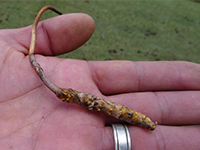Newly-identified cancer cell fingerprints in the blood could one day help doctors diagnose a range of children’s cancers faster and more accurately, according to research* presented at the National Cancer Research Institute (NCRI) Cancer Conference next week.
"We hope that this early research could eventually lead to the development of non-invasive tests which are faster, more accurate and gentler, transforming the way we make a cancer diagnosis in the future." - Dr Matthew Murray.
The researchers, from the University of Cambridge andAddenbrooke’s Hospital in Cambridge, found unique molecular fingerprints for 11 types of children’s tumours,** which could be used to develop blood tests to diagnose these cancers.
This may eventually lead to a quicker, more accurate way to diagnose tumours, and could also reduce the need for children to undergo surgery to get a diagnosis one day.
The research was funded by Sparks, the children’s medical research charity, and Cancer Research UK***.
Each year almost 1,600 children are diagnosed with cancer in the UK. These cancers tend to behave differently to cancers in adults and therefore require different treatments.
The researchers uncovered the fingerprints left by the tumours by analysing blood samples from children when they were diagnosed with cancer. They were looking for molecules that turn genes on and off, called microRNAs, to find common changes linked to different tumours.
In particular they found a very specific fingerprint which identifies different types ofneuroblastoma, a form of childhood cancer which develops from a type of nerve cell. There are around 100 new cases of the disease each year in the UK.
The research suggested that different types of tumour could be identified using a blood test which recognises the unique fingerprints produced by tumours.
The lead researchers were Dr Matthew Murray and Professor Nicholas Coleman, both from the University of Cambridge and Addenbrooke’s Hospital.
Dr Murray said: "Being diagnosed with cancer is often devastating for a child and their family, and the tests involved can be upsetting. We hope that this early research could eventually lead to the development of non-invasive tests which are faster, more accurate and gentler, transforming the way we make a cancer diagnosis in the future.
“Using a blood test instead of surgery to remove a tumour sample could improve diagnosis – such that results take a matter of hours rather than days or weeks. However, before such a test can be incorporated into clinical practice, it will now be important for these findings to be validated in other, larger independent studies.”
Dr Julia Ambler, Director of Medical Research at Sparks, said: “We are delighted to have been able to fund a project that will hopefully lead to much quicker diagnosis and treatment of childhood cancers which has the potential to benefit hundreds of children and their families each year. This project is at a really exciting stage and we are looking forward to seeing the results from the next step.”
Professor Nic Jones, Cancer Research UK’s chief scientist, said: “These early results show promise that one day a blood test could be used to diagnose these cancers. This research is the first step towards a potential test which would be very exciting, but more work needs to be done before we see this in the clinic.
“Making sure that the diagnosis and treatment of children’s cancers is much kinder in the future is urgently needed. Survival from childhood cancers has climbed to 8 in 10 in recent decades – we must continue to push the pace in this area. We need to make sure even more children survive, and there are fewer side effects from their treatment.”
Source:NCRI



